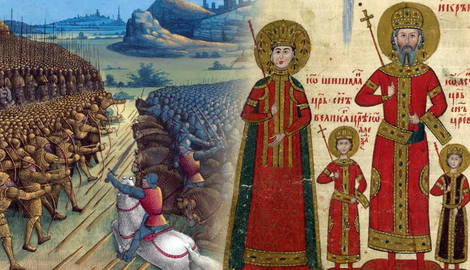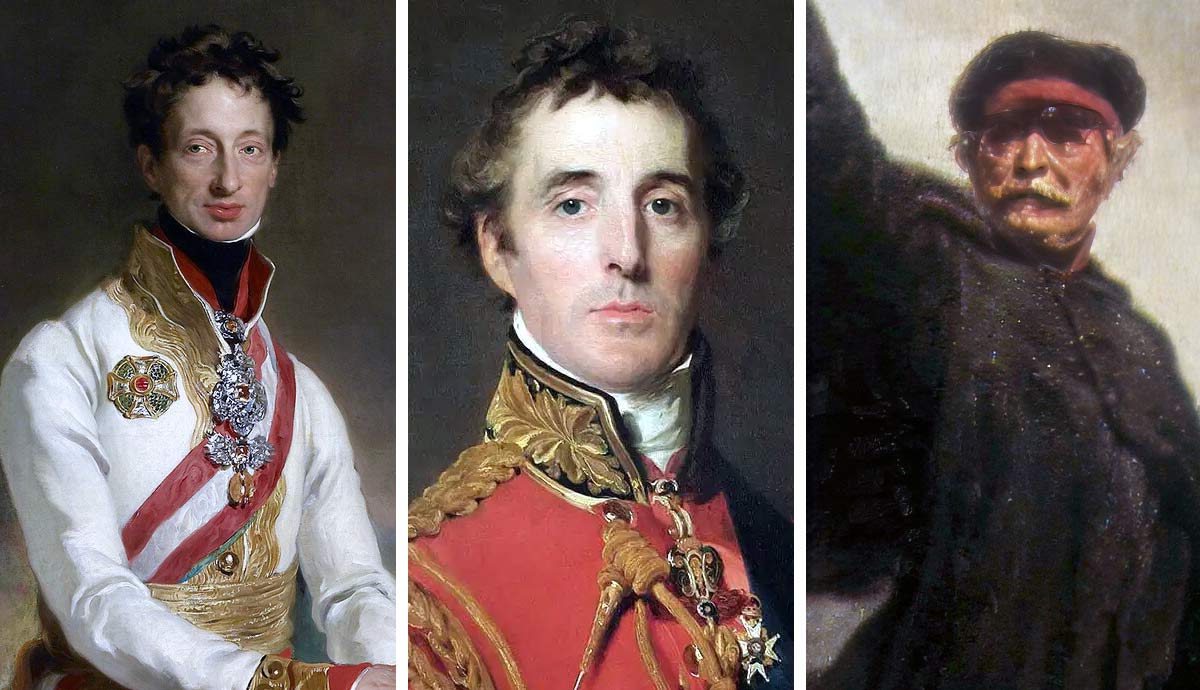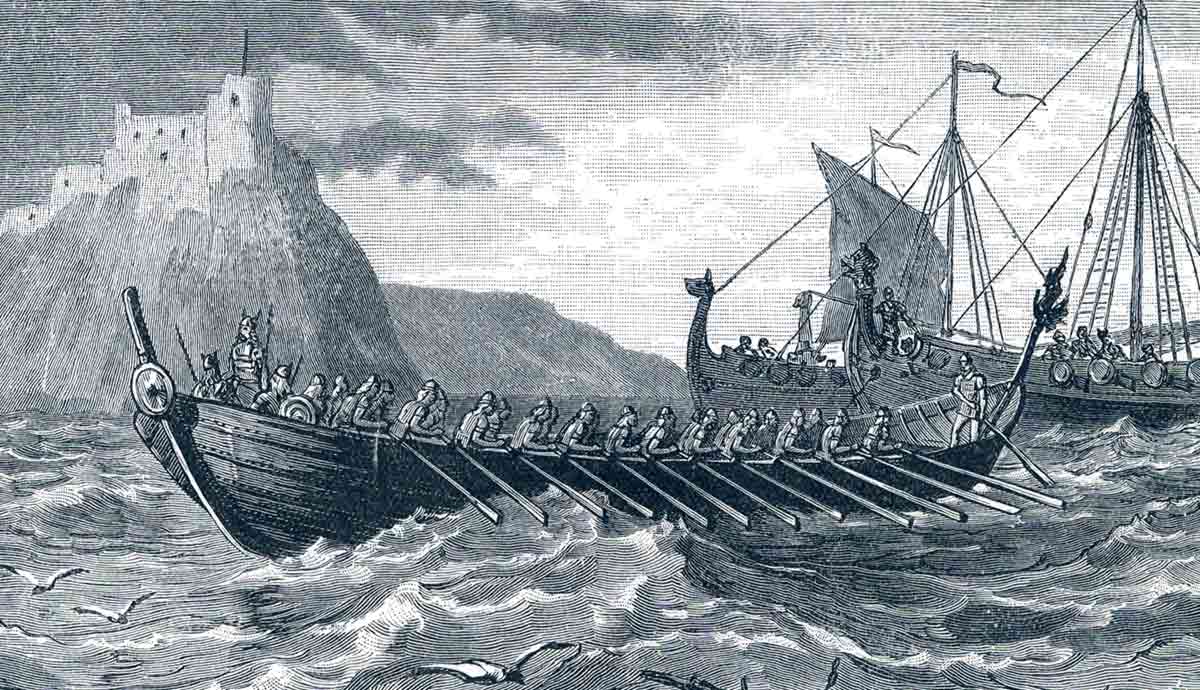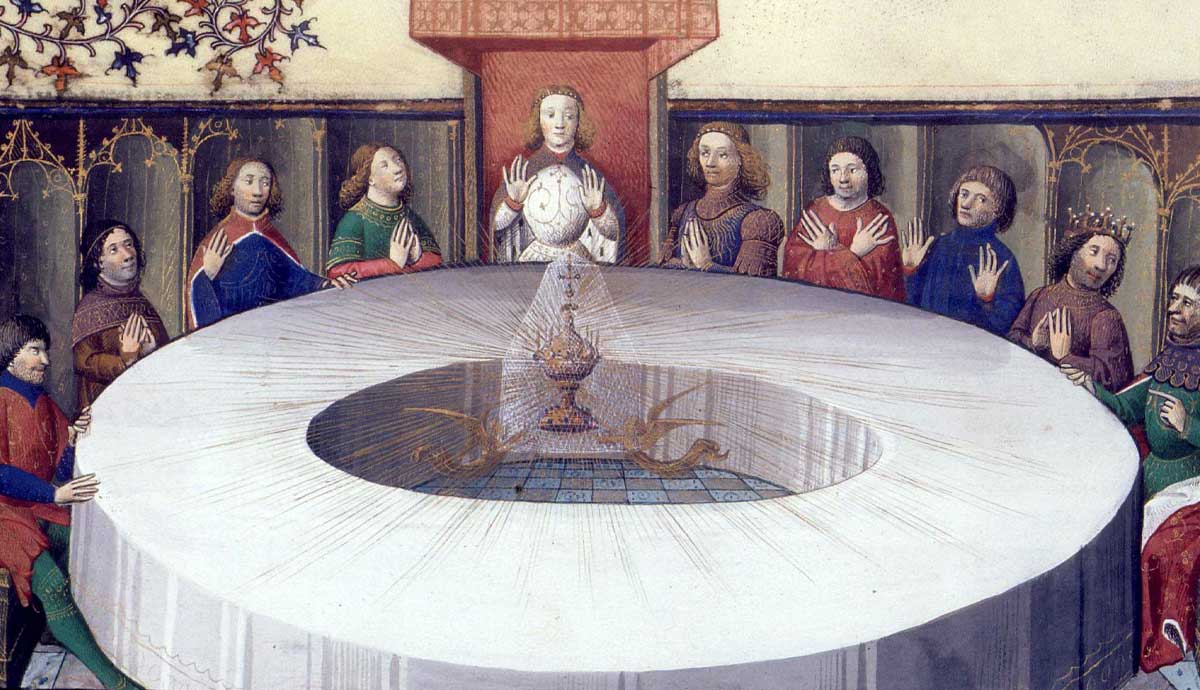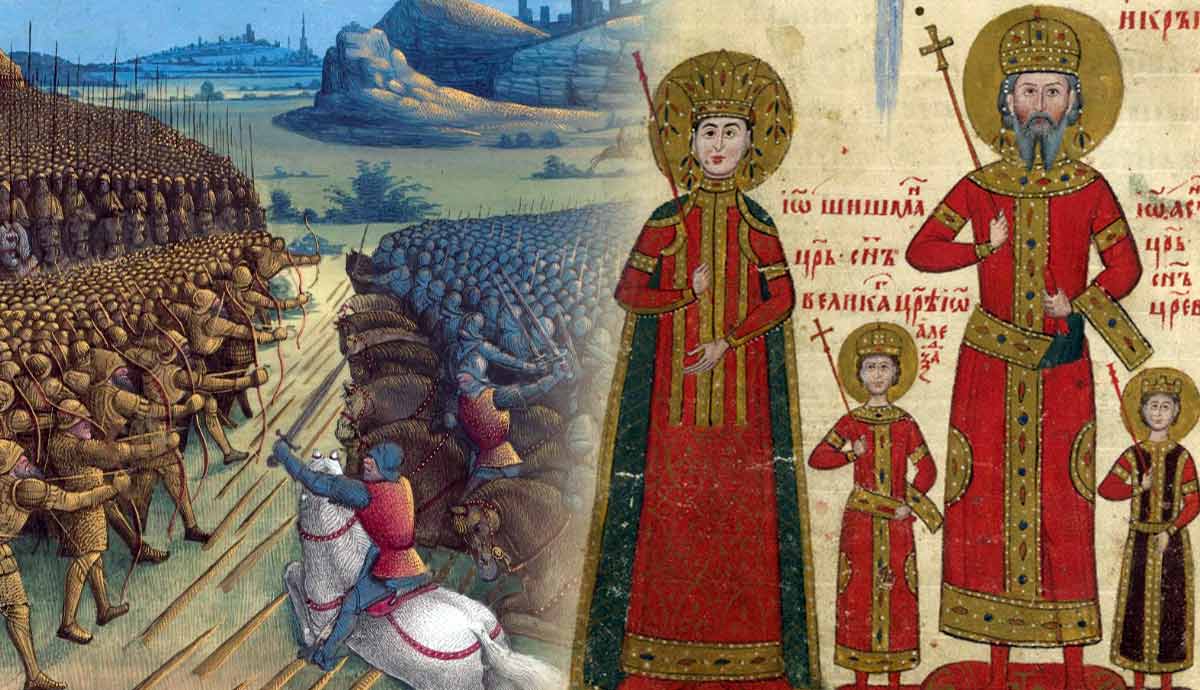
The founding of the Second Bulgarian Empire in the late 12th century saw the restoration of Bulgarian independence from Byzantine rule. Under the leadership of effective rulers such as Kaloyan and Ivan Asen II, Bulgaria conquered most of southeastern Europe from the Byzantines. The Bulgarian state was soon destabilized by the Mongol invasions and found itself frequently at war with other European neighbors. After a resurgence in the mid-14th century, the empire was conquered by the Ottomans in 1396.
Earlier Bulgarian States

The Bulgars were a Turkic nomadic people who migrated west from Central Asia around the 5th century CE and came to dominate the steppe between the Black Sea and the Caspian Sea. The first Bulgarian state, known as Old Great Bulgaria, was located north of the Black Sea and existed between 635 and 668 CE.
After Old Great Bulgaria was conquered by the Khazar Empire, the Bulgars migrated in several directions and established new political entities. The most important of these states were Volga Bulgaria, located in what is now Russia at the junction of the Volga and Kama Rivers, and the First Bulgarian Empire in the northern Balkans around the Lower Danube. Over time, the Bulgars intermarried with the Slavs, resulting in a mixed Slavic-Turkic population.
Following the introduction of Christianity in the 9th century by saints Cyril and Methodius, which led to the development of the Cyrillic script, the First Bulgarian Empire experienced a Golden Age at the beginning of the 10th century during the reign of Tsar Simeon I. Simeon’s capital of Veliki Preslav became one of the most important cities of southeastern Europe, and his domain stretched to the Adriatic coast, encompassing modern-day Serbia, North Macedonia, and Albania.
The First Bulgarian Empire was fatally weakened by the invasion of Grand Prince Svyatoslav Igorevich of Kyivan Rus’ in 968-70. The Bulgarians sought aid from the Byzantine forces, who defeated Svyatoslav in 971. Before long, the Byzantine Empire sought to make Bulgaria its vassal, and after a protracted series of wars, Bulgaria was formally annexed by the Byzantines in 1018.
The Rise of the Asen Dynasty

Over the next two centuries, the Bulgarians made several attempts to regain their independence by rebelling against the Byzantines. While these were unsuccessful, by the end of the 12th century, the Byzantines were facing a formidable challenge from the Seljuk Turks in Asia and the Norman Kingdom of Sicily in Italy.
In 1185, a pair of aristocratic brothers named Asen and Theodor were refused minor grants of land by Byzantine Emperor Isaac II Angelos. Upon returning to their base at Tarnovo, they raised the flag of rebellion on October 26, 1185, the feast day of the popular warrior saint Demetrius of Thessaloniki. Theodor was proclaimed tsar and took the title Peter II, signaling continuity with the First Bulgarian Empire. While Tsar Peter claimed the throne due to seniority, his younger brother was a better military commander and was made co-ruler as Tsar Ivan Asen in 1187.
After initial setbacks, the Bulgarian rebels gathered strength from Cuman allies and defeated the Byzantines in a series of battles. In spring 1187, Emperor Isaac personally led an army to besiege the Bulgarian fortress of Lovech but was defeated. Hostilities would resume two years later in 1189, but a Bulgarian victory at Tryavna in 1190 allowed the Bulgarians to consolidate their gains.
Kaloyan: The Warrior King

In 1192, the realm was divided between the two brothers, with Asen based in Tarnovo and Peter in Preslav. This may have been the result of a short-lived disagreement between the brothers or a more effective means of administering the state. When Asen was assassinated in 1196, Peter led an army to Tarnovo and installed their younger brother Kaloyan as tsar. Kaloyan became the sole tsar the following year when Peter was also assassinated.
During his decade on the throne, the 30-year-old Kaloyan proved to be one of the most effective rulers in Bulgarian history. In around 1200, he sought recognition of Bulgarian statehood from Byzantine emperor Alexius III Angelus but was refused. In 1204, the armies of the Fourth Crusade decided to sack Constantinople rather than go to the Holy Land. With the Roman Church in the ascendancy, Kaloyan negotiated with Pope Innocent III and received recognition as King of the Bulgarians and the Vlachs.
However, the Latin armies in the Balkans were soon raiding Bulgarian territories, while Greek rebels in Thrace appealed to Kaloyan for protection. The Bulgarian ruler answered their call and led his army to relieve the Siege of Adrianople (present-day Edirne, Turkey.) On April 14, 1205, Kaloyan’s Cuman light cavalry attacked the enemy camp while they were celebrating Easter. The Cumans then withdrew, leading the enraged Crusaders into an ambush by elite Bulgarian troops. The Latin knights were isolated, and Emperor Baldwin I was captured and taken to Tarnovo, where he died in captivity later that year.
Ivan Asen II: Zenith of the Empire

Following victory at the Battle of Adrianople, Kaloyan continued to attack the Latins and their Greek supporters. His brutality alienated his Thracian allies, who turned against him. Kaloyan died in October 1207 under mysterious circumstances while leading the siege of Thessaloniki. He was succeeded by his nephew Boril, the son of an unnamed sister, who consolidated his claim to the throne by marrying Kaloyan’s widow.
Boril’s claim to the throne was not recognized by his cousin Ivan Asen, the son and namesake of Asen I. Boril struggled to regain his Thracian territories and was compelled to make peace with the Latin Empire in 1213. However, not long after Emperor Henry died in 1216, Ivan Asen invaded Bulgaria and laid siege to Boril in Tarnovo. He captured the capital in 1218, took Boril captive, and became tsar in his place.
The Second Bulgarian Empire reached its zenith during the reign of Ivan Asen II. His greatest achievement came in 1230, when he defeated Theodore Comnenus, Despot of Epirus, at the Battle of Klokotnitsa in southern Bulgaria. As a result, Macedonia, Thessaly, Thrace, and eastern Albania were annexed to Bulgaria. Theodore’s brother and successor, Michael, who retained control of central and northern Greece, effectively became a Bulgarian vassal.
In 1235, Ivan Asen II cut his ties with the Pope and returned to Orthodox Christianity. During his reign, Tarnovo became a prominent political, cultural, and religious center and styled itself the Third Rome, challenging the weakened Constantinople.
Fall of the Asens

Like his uncle Kaloyan, Ivan Asen’s success proved short-lived. The young sons who succeeded him were both murdered and by 1257, the male line of the Asen dynasty was extinguished. Over the following decades, the Bulgarian throne was contested by several claimants, some of whom married Asen princesses to strengthen their legitimacy.
In the meantime, the Latin Empire collapsed, leaving behind rival Greek claimants for the Byzantine throne. In 1261, Emperor Michael VIII Palaiologos captured Constantinople, leading to a revival of Byzantine fortunes. At this time, the nobleman Konstantin Tih consolidated his control in Bulgaria and formed an alliance with Michael VIII.
Since the 1240s, Bulgaria had been subject to regular raids by Mongol-Tatars, which devastated the countryside. In 1277, an illiterate peasant named Ivaylo organized an army to resist the Mongol hordes and unexpectedly won several battles. Recognizing that Ivaylo’s successes undermined his own authority, Tsar Konstantin led an army against him and was killed in battle.
In order to protect her position, Konstantin’s widow Maria Kantakouzena proposed marriage to Ivaylo, who was proclaimed tsar in 1278. Emperor Michael VIII, who was Maria’s uncle, sought to do away with Ivaylo and installed as tsar Ivan Asen III, a grandson of Ivan Asen II through the female line. Though Ivaylo defeated a Byzantine army, forcing the puppet tsar to flee, the Bulgarian elites decided to elect the aristocrat George Terter as tsar. Ivaylo was killed while seeking assistance from the Mongols.
Revival and Resurgence

Although Tsar George had some success in putting an end to the political disorder, his realm was much reduced, and he proved incapable of resisting further Mongol incursions. In 1292, he was overthrown by Nogai Khan of the Golden Horde, who placed a Bulgarian nobleman named Simlets on the throne. In 1299, Nogai Khan’s son Chaka invaded Bulgaria and briefly took the crown for himself. However, he was soon overthrown and killed by his erstwhile ally Theodore Svetoslav, son of George Terter I.
Theodore Svetoslav restored Bulgarian independence and led a revival of Bulgarian fortunes by leading a successful campaign in 1303-04 to reconquer Thracian territories lost during Ivaylo’s revolt. He established his southeastern frontier at the Veleka River. In 1307, he formed an alliance with Byzantine emperor Michael IX Palaiologos and intervened in a Byzantine civil war that broke out in 1321.
Theodore Svetoslav died in 1322 and was succeeded by his son George Terter II. The young tsar managed to conquer the city of Philippopolis (present-day Plovdiv) and its hinterland but died of natural causes the following year. He was succeeded by his cousin Michael Shishman, who took the title Michael Asen III to emphasize his descent from the Asen dynasty. The ambitious Tsar Michael was initially successful against the Byzantines but was killed in 1330 while waging war against Serbia. His son and successor, Ivan Stefan, was overthrown after a year.

The cousin of the deposed Ivan Stefan, Ivan Alexander, successfully consolidated his control of the empire during the 1330s. In 1344, he expanded his realm south of Plovdiv by taking advantage of another Byzantine civil war and thus controlled a state that roughly corresponds to the borders of modern-day Bulgaria.
Ivan Alexander’s reign ushered in a second Golden Age of Bulgarian art and culture, exemplified by the illustrations in the Gospels of Tsar Ivan Alexander, now held in the British Library. However, the tsar’s foreign policy would sow the seeds for Bulgaria’s destruction. In the northwest, he installed his son Ivan Sracimir as ruler of Vidin, but the latter was forced to acknowledge Hungarian overlordship. Meanwhile, the Bulgarian ruler had refused Byzantine appeals for aid to confront the Ottoman Turks, who conquered Adrianople in the 1360s and established a foothold on the Balkan peninsula.
When Ivan Alexander died in 1371, he was succeeded in Tarnovo by his younger son Ivan Shishman. Ivan Sracimir continued to rule in Vidin and refused to acknowledge the authority of his half-brother in Tarnovo.
Fall and Conquest

In an attempt to head off an Ottoman invasion, Ivan Shishman submitted to the Ottomans in 1373. However, this failed to prevent Ottoman raids into Bulgarian territory, and in 1387, the Bulgarian tsar sought to reclaim his independence with support from Serb and Bosnian allies. The defeat of the Serb army at the Battle of Kosovo in 1389 prompted Shishman to seek aid from Hungary.
While Ivan Shishman was besieged at the fortress of Nicopolis (Nikopol) on the Danube in 1193, the Ottomans captured his capital of Tarnovo. With promises of Hungarian support, the Bulgarian ruler continued to hold out but was captured in 1395. He was either killed immediately or taken captive and died in prison.
In 1396, King Sigismund of Hungary led a European coalition to besiege Nicopolis but was defeated decisively at the Battle of Nicopolis by the Ottoman sultan Bayezid I. Ivan Sracimir, Tsar of Vidin, fought alongside the Christian armies but was captured and poisoned the following year. The Ottomans duly incorporated the territories of Vidin into their expanding European domains.
From his exile in Serbia, Sracimir’s son Konstantin claimed the title of tsar of Bulgaria. Although he led a revolt against the Ottoman authorities between 1408 and 1413, his forces were eventually defeated, and the territories he had left were annexed by the Ottomans in 1422, shortly before his death. Bulgaria remained under Ottoman rule for four-and-a-half centuries until its independence was restored after the Russo-Turkish War of 1877-78.
